NISSAN LEAF 2017 1.G Roadside Assistance Guide
Manufacturer: NISSAN, Model Year: 2017, Model line: LEAF, Model: NISSAN LEAF 2017 1.GPages: 39, PDF Size: 1.32 MB
Page 31 of 39
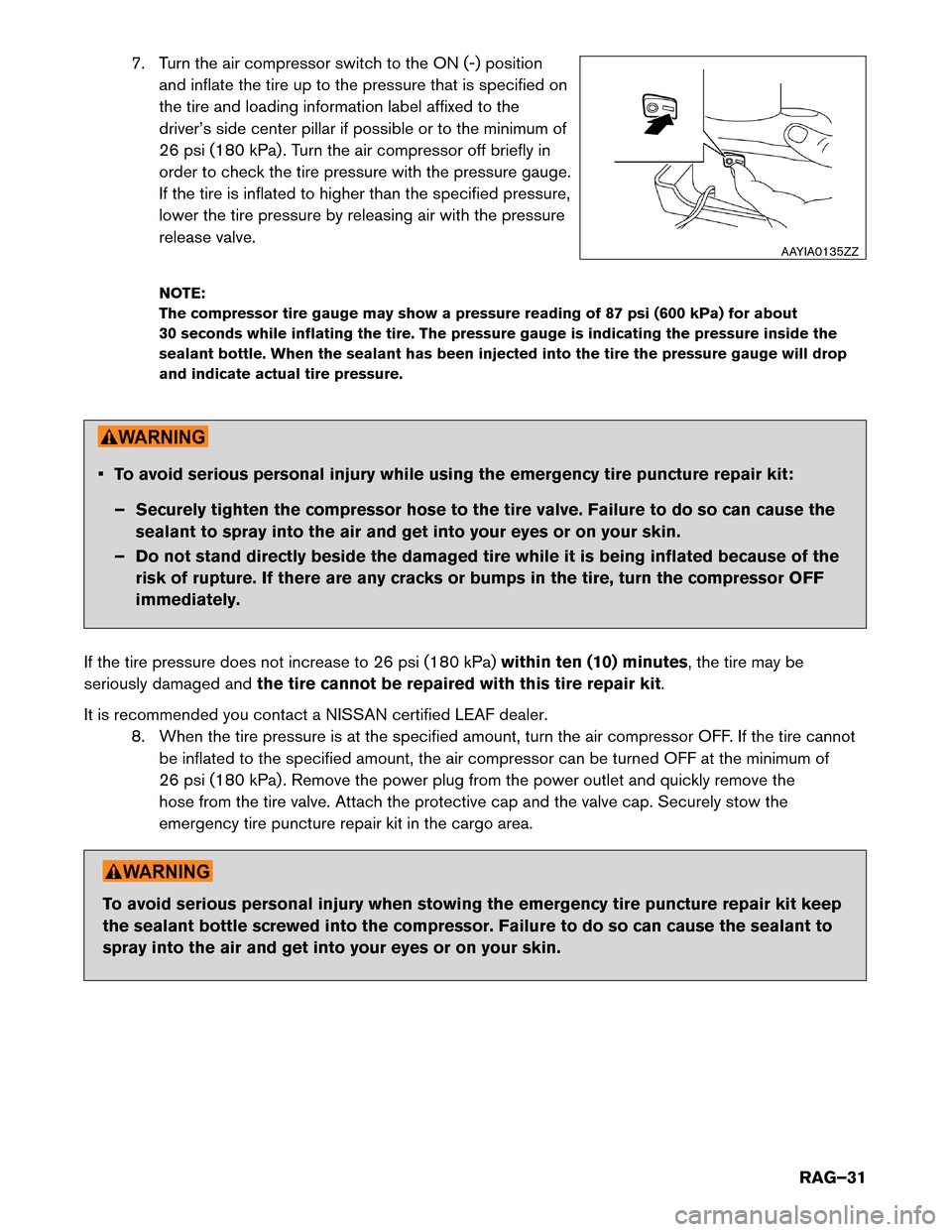
7. Turn the air compressor switch to the ON (-) position
and inflate the tire up to the pressure that is specified on
the tire and loading information label affixed to the
driver’s side center pillar if possible or to the minimum of
26 psi (180 kPa) . Turn the air compressor off briefly in
order to check the tire pressure with the pressure gauge.
If the tire is inflated to higher than the specified pressure,
lower the tire pressure by releasing air with the pressure
release valve.
NOTE:
The compressor tire gauge may show a pressure reading of 87 psi (600 kPa) for about
30 seconds while inflating the tire. The pressure gauge is indicating the pressure inside the
sealant bottle. When the sealant has been injected into the tire the pressure gauge will drop
and indicate actual tire pressure. • To avoid serious personal injury while using the emergency tire puncture repair kit:
–
Securely tighten the compressor hose to the tire valve. Failure to do so can cause the
sealant to spray into the air and get into your eyes or on your skin.
– Do not stand directly beside the damaged tire while it is being inflated because of the risk of rupture. If there are any cracks or bumps in the tire, turn the compressor OFF
immediately.
If the tire pressure does not increase to 26 psi (180 kPa) within ten (10) minutes, the tire may be
seriously damaged and the tire cannot be repaired with this tire repair kit.
It is recommended you contact a NISSAN certified LEAF dealer. 8. When the tire pressure is at the specified amount, turn the air compressor OFF. If the tire cannotbe inflated to the specified amount, the air compressor can be turned OFF at the minimum of
26 psi (180 kPa) . Remove the power plug from the power outlet and quickly remove the
hose from the tire valve. Attach the protective cap and the valve cap. Securely stow the
emergency tire puncture repair kit in the cargo area. To avoid serious personal injury when stowing the emergency tire puncture repair kit keep
the
sealant bottle screwed into the compressor. Failure to do so can cause the sealant to
spray into the air and get into your eyes or on your skin. AAYIA0135ZZ
RAG–31
Page 32 of 39
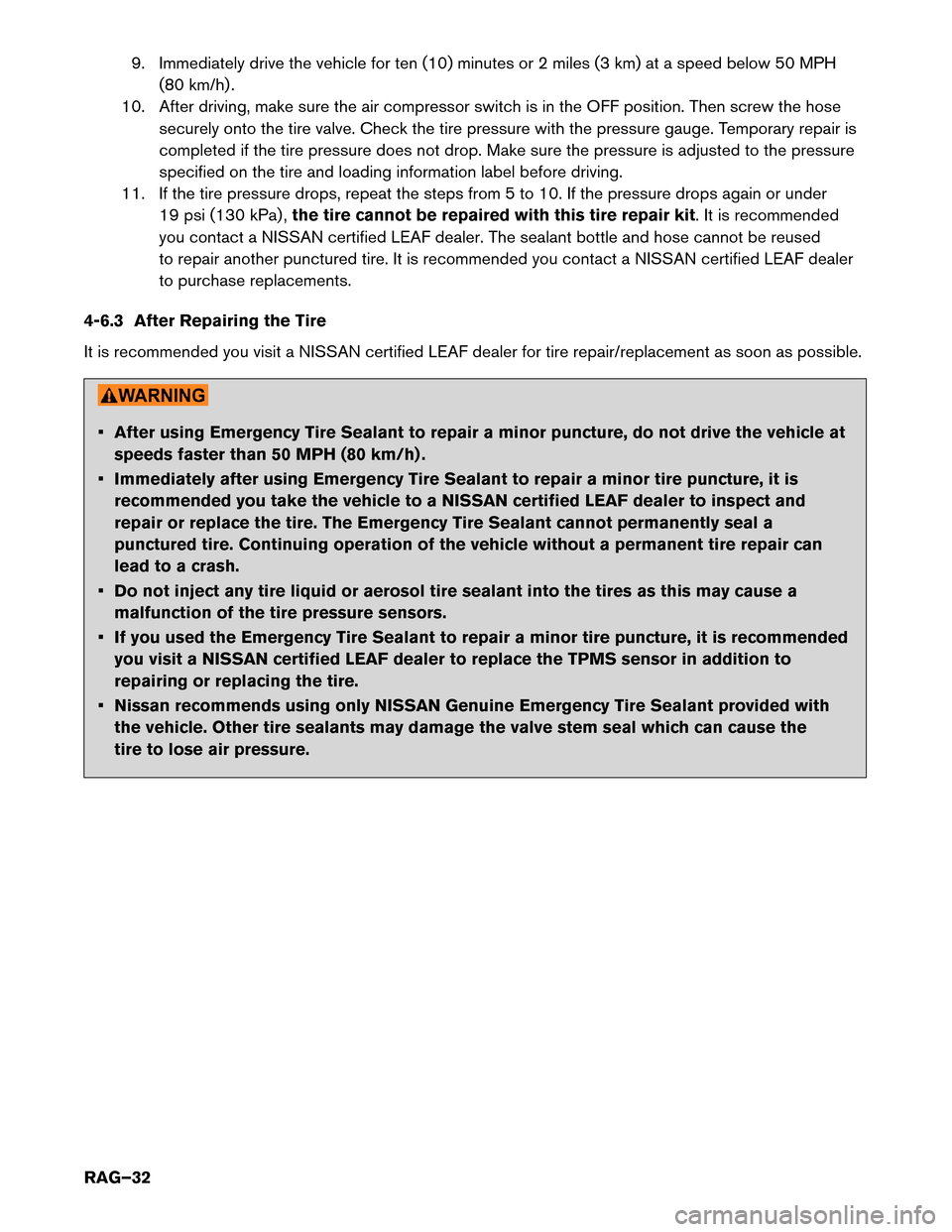
9. Immediately drive the vehicle for ten (10) minutes or 2 miles (3 km) at a speed below 50 MPH
(80 km/h) .
10. After driving, make sure the air compressor switch is in the OFF position. Then screw the hose securely onto the tire valve. Check the tire pressure with the pressure gauge. Temporary repair is
completed if the tire pressure does not drop. Make sure the pressure is adjusted to the pressure
specified on the tire and loading information label before driving.
11. If the tire pressure drops, repeat the steps from 5 to 10. If the pressure drops again or under 19 psi (130 kPa) , the tire cannot be repaired with this tire repair kit. It is recommended
you contact a NISSAN certified LEAF dealer. The sealant bottle and hose cannot be reused
to repair another punctured tire. It is recommended you contact a NISSAN certified LEAF dealer
to purchase replacements.
4-6.3 After Repairing the Tire
It is recommended you visit a NISSAN certified LEAF dealer for tire repair/replacement as soon as possible. • After using Emergency Tire Sealant to repair a minor puncture, do not drive the vehicle at
speeds
faster than 50 MPH (80 km/h) .
• Immediately after using Emergency Tire Sealant to repair a minor tire puncture, it is recommended you take the vehicle to a NISSAN certified LEAF dealer to inspect and
repair or replace the tire. The Emergency Tire Sealant cannot permanently seal a
punctured tire. Continuing operation of the vehicle without a permanent tire repair can
lead to a crash.
• Do not inject any tire liquid or aerosol tire sealant into the tires as this may cause a malfunction of the tire pressure sensors.
• If you used the Emergency Tire Sealant to repair a minor tire puncture, it is recommended you visit a NISSAN certified LEAF dealer to replace the TPMS sensor in addition to
repairing or replacing the tire.
• Nissan recommends using only NISSAN Genuine Emergency Tire Sealant provided with the vehicle. Other tire sealants may damage the valve stem seal which can cause the
tire to lose air pressure.
RAG–32
Page 33 of 39
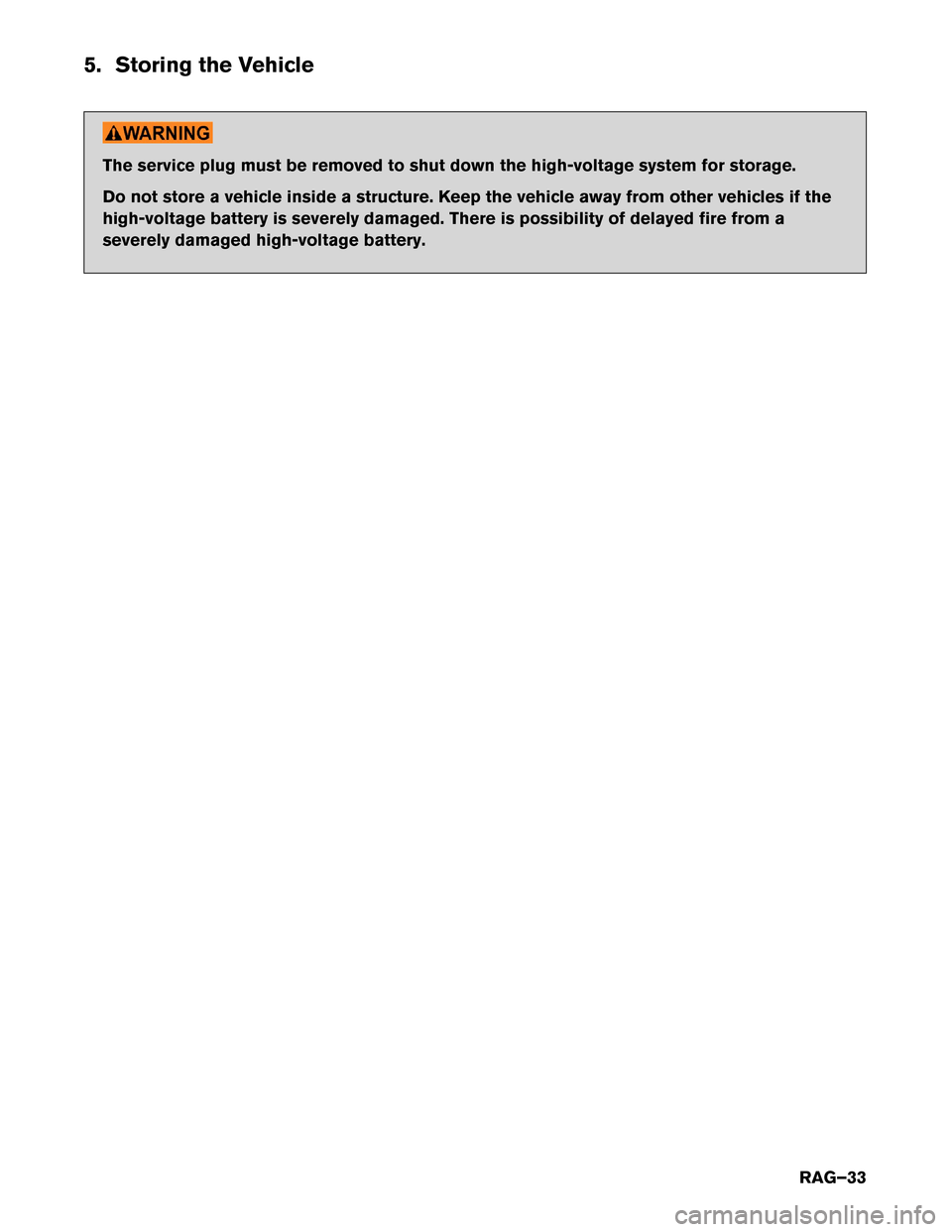
5. Storing the Vehicle
The service plug must be removed to shut down the high-voltage system for storage.
Do
not store a vehicle inside a structure. Keep the vehicle away from other vehicles if the
high-voltage battery is severely damaged. There is possibility of delayed fire from a
severely damaged high-voltage battery.
RAG–33
Page 34 of 39
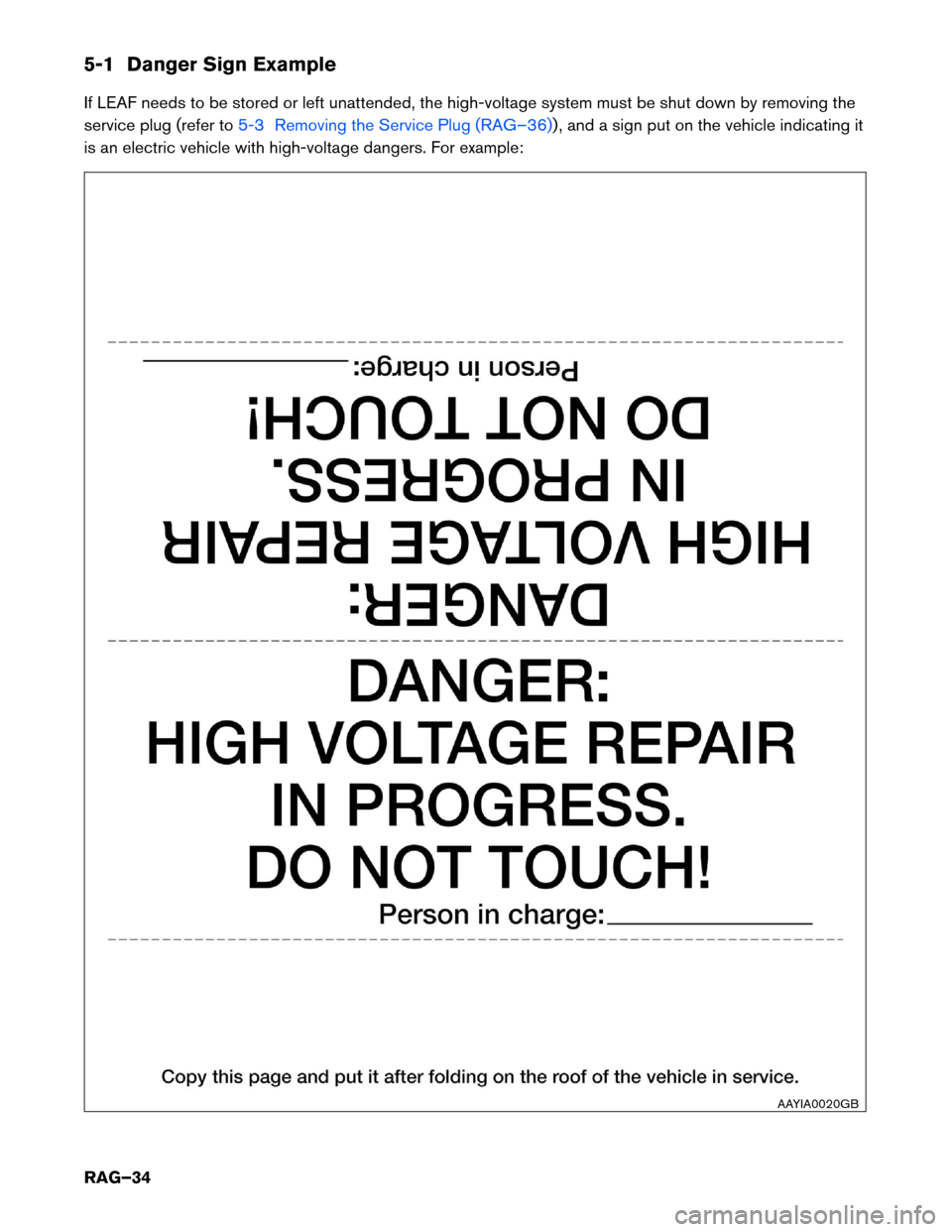
5-1 Danger Sign Example
If
LEAF needs to be stored or left unattended, the high-voltage system must be shut down by removing the
service plug (refer to 5-3 Removing the Service Plug (RAG–36)) , and a sign put on the vehicle indicating it
is
an electric vehicle with high-voltage dangers. For example: AAYIA0020GB
RAG–34
Page 35 of 39

5-2 Preparation Items
Preparation Items
Specification Purpose
Personal Protective Equipment
(PPE):
Insulated gloves Up to 1,000V
For protection from high-voltage
electrical
shock
Insulated shoes –
Safety
shield –
Leather
gloves Must be able to fasten tight
around
the wrist (worn over
insulated gloves) . To protect insulated gloves
Wrenches Size:10mm
To remove the service plug access
cover
bolts.
To remove the 12-volt battery
terminal bolt.
Solvent resistant protection
gloves –
To utilize in the event of a high-
voltage battery electrolytic solution
leak.
Solvent resistant protection
shoes –
Absorbent pad The same pad used for internal
combustion engine fluids can be
used. To absorb any high-voltage battery
electrolytic solution leakage.
Standard fire fighting equipment Standard fire fighting equipment Depending on type of fire
(vehicle or battery) use standard
fire fighting equipment (water or
extinguisher) .To extinguish a fire.
Insulated tape InsulatingTo cover any damaged harnesses to
protect from and prevent electrical
shock. Tape should cover all bare or
damaged wire.
5-2.1 Personal Protective Equipment (PPE) Protective Wear Control
Perform an inspection of the Personal Protective Equipment (PPE) items before beginning work. Do not use
any damaged PPE items.
RAG–35
Page 36 of 39
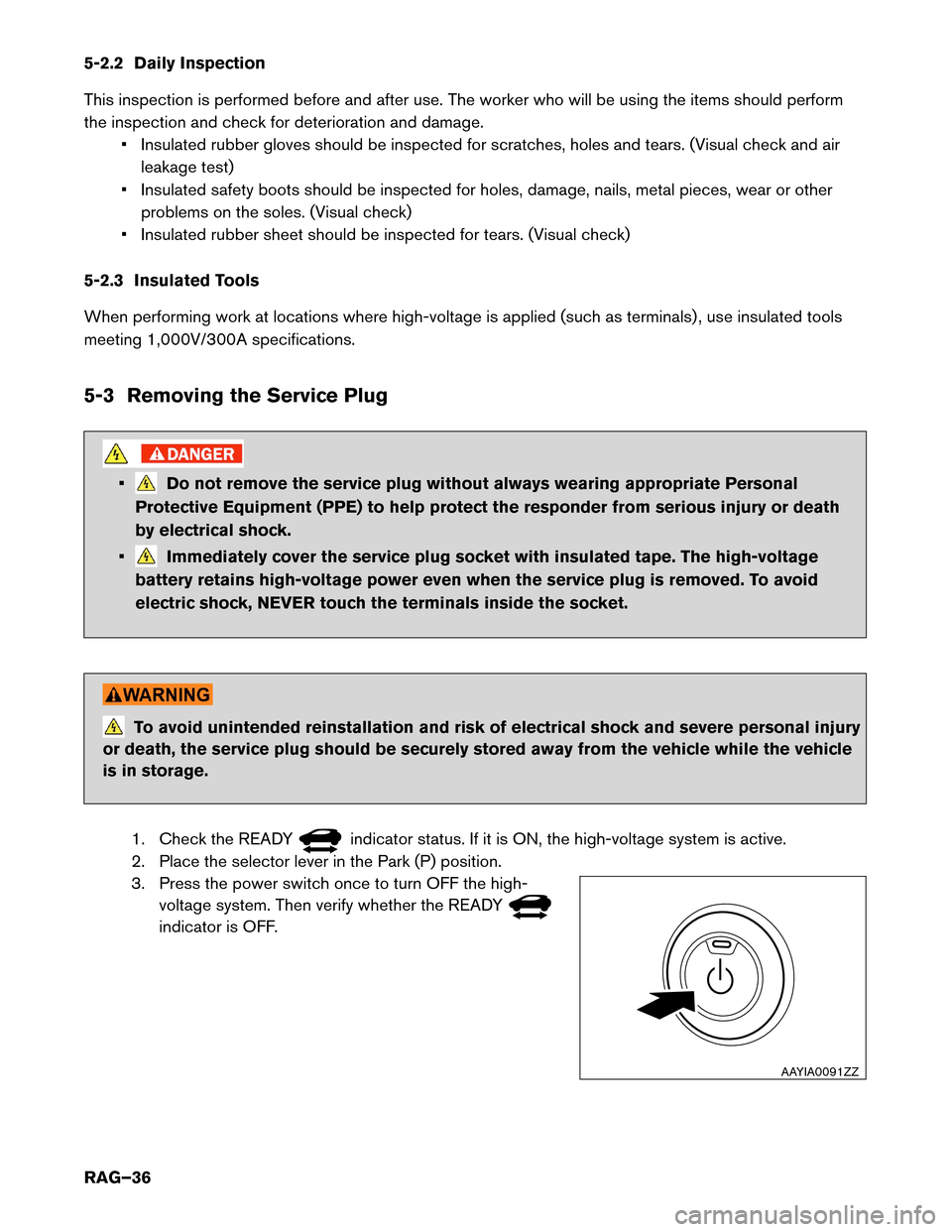
5-2.2 Daily Inspection
This
inspection is performed before and after use. The worker who will be using the items should perform
the inspection and check for deterioration and damage. • Insulated rubber gloves should be inspected for scratches, holes and tears. (Visual check and airleakage test)
• Insulated safety boots should be inspected for holes, damage, nails, metal pieces, wear or other problems on the soles. (Visual check)
• Insulated rubber sheet should be inspected for tears. (Visual check)
5-2.3 Insulated Tools
When performing work at locations where high-voltage is applied (such as terminals) , use insulated tools
meeting 1,000V/300A specifications.
5-3 Removing the Service Plug • Do not remove the service plug without always wearing appropriate Personal
Protective
Equipment (PPE) to help protect the responder from serious injury or death
by electrical shock.
• Immediately cover the service plug socket with insulated tape. The high-voltage
battery
retains high-voltage power even when the service plug is removed. To avoid
electric shock, NEVER touch the terminals inside the socket. To avoid unintended reinstallation and risk of electrical shock and severe personal injury
or
death, the service plug should be securely stored away from the vehicle while the vehicle
is in storage.
1. Check the READY indicator status. If it is ON, the high-voltage system is active.
2.
Place the selector lever in the Park (P) position.
3. Press the power switch once to turn OFF the high- voltage system. Then verify whether the READY indicator is OFF.
AAYIA0091ZZ
RAG–36
Page 37 of 39
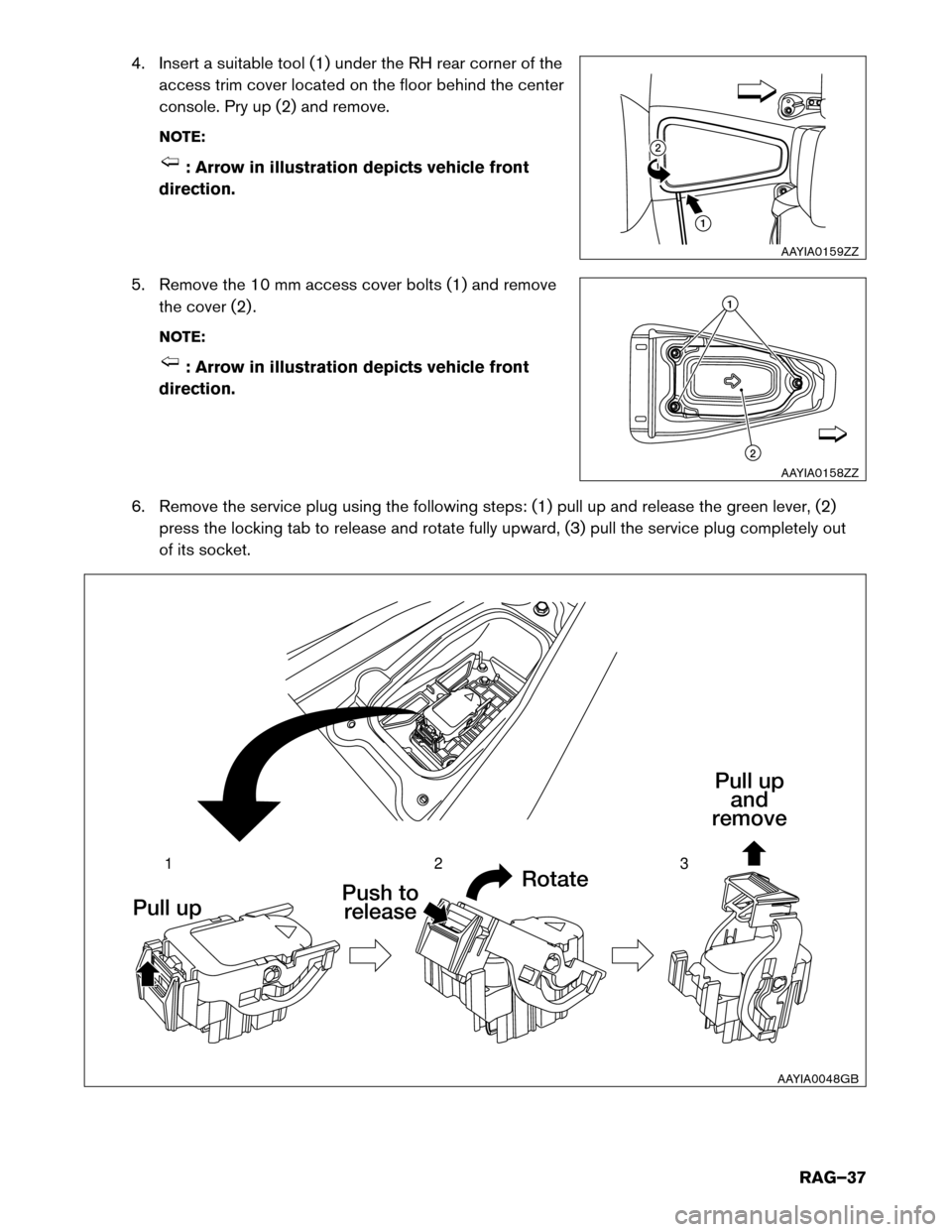
4. Insert a suitable tool (1) under the RH rear corner of the
access trim cover located on the floor behind the center
console. Pry up (2) and remove.
NOTE: : Arrow in illustration depicts vehicle front
direction.
5.
Remove the 10 mm access cover bolts (1) and remove
the cover (2) .
NOTE: : Arrow in illustration depicts vehicle front
direction.
6.
Remove the service plug using the following steps: (1) pull up and release the green lever, (2)
press the locking tab to release and rotate fully upward, (3) pull the service plug completely out
of its socket. 12
AAYIA0159ZZ
1
2
AAYIA0158ZZ
1
2
3
Pull up Rotate
Push to
release Pull up
and
remove
AAYIA0048GBRAG–37
Page 38 of 39
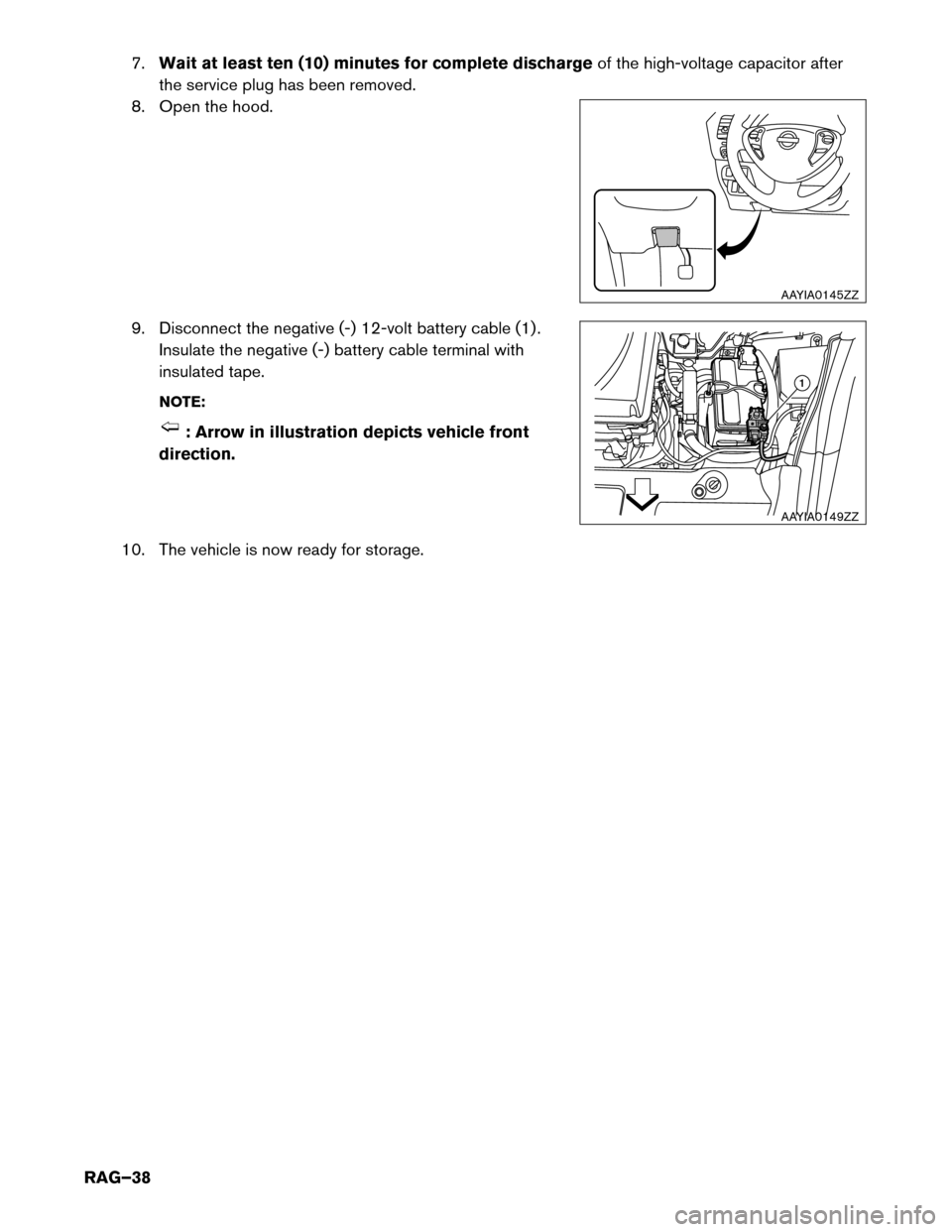
7.
Waitat least ten (10) minutes for complete discharge of the high-voltage capacitor after
the service plug has been removed.
8. Open the hood.
9. Disconnect the negative (-) 12-volt battery cable (1) . Insulate the negative (-) battery cable terminal with
insulated tape.
NOTE: : Arrow in illustration depicts vehicle front
direction.
10.
The vehicle is now ready for storage. AAYIA0145ZZ
1
AAYIA0149ZZ
RAG–38
Page 39 of 39

© 2016 Nissan North America, Inc.
All
rights reserved.
This document may not be altered without the written permission of Nissan North America, Inc.
Pub. No. RG17EA0ZE0U0